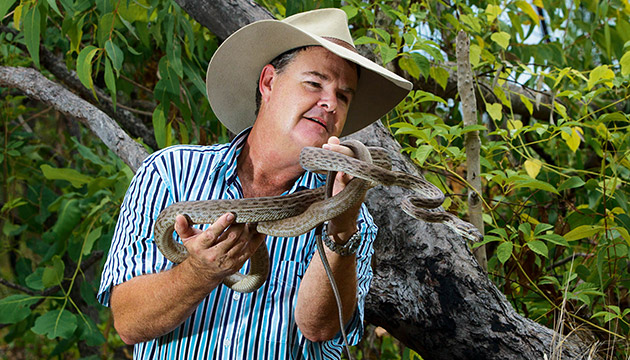A Top End scientist has devoted his career to saving a large, elusive snake, with the help of traditional land owners.
Story By David Hancock
Top End herpetologist Dr Gavin Bedford expected the search for one of Australia’s largest and rarest snakes to be akin to looking for a needle in a haystack, but after scouring likely places in remote Arnhem Land he believes the Oenpelli python may be close to extinction.
So far he has spent 1400 hours poking around stony country near Kakadu National Park and more than $20,000 of his own money choppering into remote areas. In that time he has seen and captured only two Oenpelli pythons, a young female measuring 2.4 metres and a more mature female measuring 4.2m.
The Oenpelli python was first described by Europeans in 1977 but it has long been recognised as an important totemic creature by Bininj Aboriginal people of western Arnhem Land, particularly those living around the headwaters of the East Alligator River. The animal features in rock art and some anthropologists link it to creation stories about the rainbow serpent.
The Oenpelli python is long and thin and can grow to at least five metres. It is dark olive-brown with darkened blotches and takes on an ethereal silver-grey colour at night. The snake is an ambush predator that remains motionless for long periods while catching prey such as rock rats, possums, bats and other mammals.
It is a secretive, shy creature that lives among sandstone outcrops in western Arnhem Land and sometimes ventures into the tropical woodland to hunt, often climbing into trees. Little is known about the Oenpelli python and, in 2011, the Northern Territory government gave Gavin permission to collect eight pythons to establish a captive-breeding program.
A wildlife researcher and former commercial snake breeder, Gavin was concerned by studies of small mammals in the Top End that showed a wave of extinctions were occurring, similar to the wave that swept through central Australia when Europeans first arrived. This concerned him because the Oenpelli python feeds exclusively on small mammals.
“Parks and Wildlife [officers] are monitoring the situation but no one is doing anything,” he says. “Extinction is the last thing you want and I believe that will happen if we don’t have any of these animals in captivity. Captivity isn’t the ultimate solution but it does have a part to play.”
This Story is from Issue #88
Outback Magazine: Apr/May 2013










